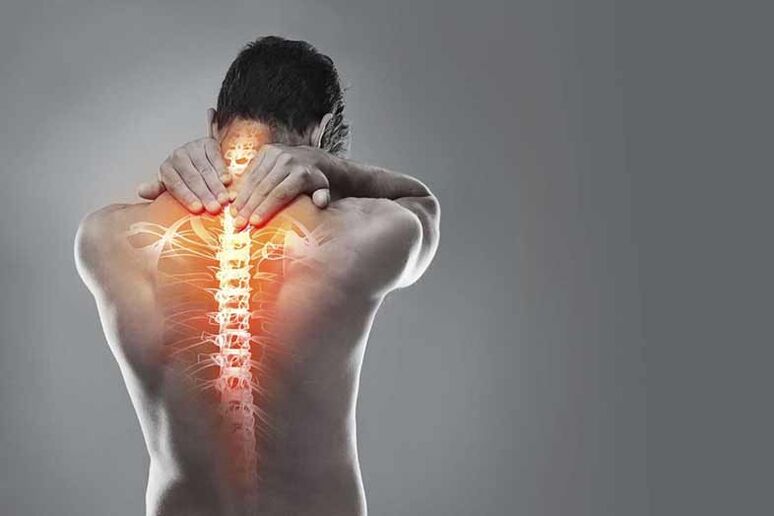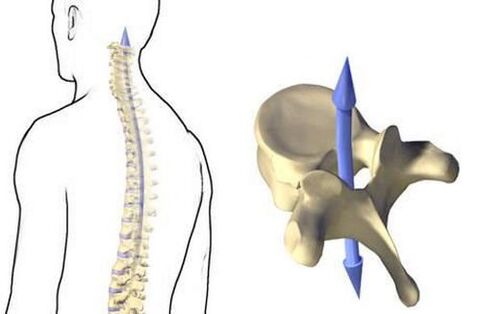
According to statistics, almost half of people from 30 to 55 years of age suffers from osteochondrosis.The lower age threshold of the disease in recent years has decreased at 18 years.
What is osteochlandosis
Osteochondrosis of the spineIt is expressed in the defeat of the intervertebral disc, which loses its elasticity, elasticity, cracks.
Cervical osteochondrosisassociated with damage to the discs in the cervical column.
How the spine works
If for a better understanding a little simplified the essence, the device of the spine can be described as follows.
The spine is made up of separate, similar to each other in the form of a vertebrae located one above the other.
Despite some differences in the form, in the structure of all the vertebrae, there is a common one.There is a hole in each vertebra: all the holes are also one above the other and form a vertical channel (tunnel) that passes through the entire spine.
Within this spinal canal, the spinal cord passes.Pass vertically through the holes in each vertebra and its roots (branches, in which sensitive nerve terms) leave the canal between every torque of vertebrae.This is possible because the vertebrae is not lost with each other and are not firmly fixed, and between each torque of vertebrae there is a cartilage: an intervertebral disc.

The wheels together with the ligaments connect the vertebrae between them and also play the role of the impact absorbitor.Due to their elastic structure, elastic elastic are compressed during the movements and inclinations of the body (on the inclination side) or not allowed (during straightening).Therefore, the discs provide the vertebral column flexibility and soften the load from the vertical pressure from top to bottom to each spinal spine vertebral vertebral, as well as the vertical vibrations upwards that occur during walking or running.After all, a person is a unique erect and direct creature.
This work of the spine is guaranteed if the entire load is distributed correctly.Nature created the incredibly stable, resistant and at the same time flexible spine.
And if not?
If the shape of the spine, conceived by nature, for some reason it is violated (fold, excessive fold in the lower back, scoliosis, flat feet) or a constant chronic habit of sitting, lying down, standing, intervertebral compounds begin to wear their elasticity, the ability to perform the function of shocking of the shock, are full of demolition, crack and demolished and demolished and demolished and demolisheddeformed.They protrude on the sides, forming an hernia.
The wear of the intervertebral discs: there is also a person of a person for the vertical.After all, only in humans the spine has a vertical load.This vertical squeezing for the whole life of all the components of the spine (especially in people with excess weight) leads to a gradual deterioration of the blood supply to intervertebral discs (the vascular direction is squeezed): the disc loses resistance and strength.
What later?

Disco Hernia standsBlood vessels,Nerve rootsAnd sometimesspinal cord.
The consequences of cervical osteochondosis
Due to the changes in anatomical relationships in the spine, the blood vessels (the arteries and the main veins) are squeezed.
What is going on:Due to the changes in anatomical relationships in the spine, the blood vessels (the arteries and the main veins) are squeezed.What leads to:
- to a violation of the blood flow in the brain and a violation of full diet of the brain.
- to a violation of the venous outflow and the accumulation of toxic substances in the brain tissues.
How it manifests itself:
- Dizziness (loss of consciousness up to the short term).
- Heachache.
- Visual impairment.Violation of the smell, taste.
- Bulbare disorders associated with the difficulties of swallowing, pronunciation, violation of general and vocal breathing.
- Cognitive disorders: compromised memory, perception, complexity with concentration of attention, complexity with logical thought.Violation of reading.
- Absent -Idhe.Inappropriate.Decrease in confusion.Forgetfulness.
- Difficulty with pronounced complex and long words, complex grammatical constructions.
- Reduced performance, overload.
- Violations in the emotional and personal sphere: clear and unreasonable mood changes, emotional incontinence, irritability, anger.
Diagnosis: Cognitive disorders, aphasia, bulbar disartria, descent encephalopathy, vertebro-baslar insufficiency (VBN), etc. can be diagnosed. Drug therapy taken in these cases:
- Vascular drugs.They have an extremely low test base.They require the use of the doctor and under the control of a doctor, they can cause a large number of different complications and side effects.
- Nootropi drugs.Request the use strictly for the appointment and under the check of a doctor.Many have rather serious contraindications from the cardiovascular system (with hidden heart disease, they can cause serious negative consequences).Most nootropes have no positive pharmacological result, that is, it is useless.
- Drugs with sedative effect, including tranquilizers, antidepressants, barbiturates, bromuries.Psychotropic drugs.Request the use strictly for the appointment and under the check of a doctor.They can create dependence and have more side effects (dizziness, headache, visual impairment and urination, dry fats, nausea, etc. disgrace disorders, a decrease in libido, sleep disorders, a series of body weight).
There is a narrow (compression) of nerve roots - nerves from the spinal cord to the organs and tissues of the upper body.
What is going on:
There is a narrow (compression) of nerve roots - nerves from the spinal cord to the organs and tissues of the upper body.
What leads to: To a pronounced pain syndrome, often chronic, recurrent.
How it manifests itself:
- Neck pain, back of the head (with head turns or rest, blows or chronic).
- The headache (tension headache associated with the tension of the muscles of the rear surface of the neck and head of the head - pain, poured over the entire head, often accompanied by noise and ring in the ears, flies in front of the eyes).
- Pain in the upper part of the chest.
- Pains that simulate pain in the heart, in the lungs.
- Pain in the upper part of the back between the shoulders, the shoulders.
- Pain in the shoulder joint or in the whole hand.
- Dillerpide of fingers, hands, hands completely.
Drug therapy taken in these cases:
- Non steroidal anti -inflammatory drugs (painkillers, antipyretics), which require the use of strictly for the appointment and under the control of a doctor and have negative side reactions with a gastrointestinal tract (gastritis, ulcers, ulcerative bleeding), cardiovascular system, kidneys.
- Preparations that relieve muscle hypertonicity require use strictly for its planned purpose and under the control of a doctor and have negative side reactions in the form of strong dizziness, weakness up to completely exhausting.
The use of drug therapy is the most common practice in the treatment of osteocondrosis.However, this is a symptomatic treatment.Medicines are used to stop inflammatory processes and pain (sometimes it is necessary to resort to the blocking of novocaine), a decrease in neurological and psycho -emotional symptoms.The most important thing is that drug therapy occurs under the rigorous supervision of a doctor.
However, if the process of violation of the ships is not directly interrupted, do not restore the balance of the spine and all the related structures established by nature (violation of the symmetry of the body, flat feet, muscle cramps that occur as a compensatory reaction to balance), the disease do not go anywhere and at a certain point it does not help and should not help and renew the operation.
The osteopathic treatment aims to eliminate the above causes of the osteocondrosis, which today is recognized as the most effective.
Osteopathic treatment of osteochandrosis
Rule n.1 "the previous one, the better" in the case of osteochondrosis, it works above all!After all, to treat osteochondrosis - it means not to extinct the pain or other syndromes, but to restore the normal position of the spine, to provide the intervertebral disc with full lost diet (to return the flow of normal blood) even before the degenerative processes in the cartilage tissue will become irreversible.
Osteopath determines the place where movement or deformation occurredThe reasons why the ships of the ships in the spine were occurred.Osteopathy considers the body as a single system in which everything is interconnected and influences each other, literally pulls one after the other.This means that the osteopath restores the work of all the structures, the changes in which in the chain led to a violation of the power of the intervertebral disc.The task of osteopath is to restore the balance of organs and fabrics, eliminate the stress and terminals that interfere with full nutrition.And if, in the case of a neglected condition of the disease, the changes in the structure of the spine involved a violation of the work of the internal organs, the osteopathic treatment will have aimed at eliminating emerging dysfunctions.
That is, Osteopath works with the main cause of the disease and not with the elimination of its syndromes, including pain.Even if his work begins with this, with pain relief.However, he won't stop there.The best way of osteopathy works in combination with physiotherapy (guarantees a decrease in pain and inflammatory processes) and physiotherapy exercises - operating therapy (strengthens muscle corset, helps the body to remain in an unusual, but adequate new position).
Conclusions
- The neck cannot be treated frivolous.Since the brain should be provided with no obstacle nutrition.And it depends on how much the neck is a healthy "conductor".
- You can't wait.The more the disease is launched, the more difficult it is to leave it (and sometimes impossible).Osteopath is able to determine the disease when it is still in roughly and does not manifest itself in any way.You should never neglect a diagnostic examination.
- It is impossible to neglect the prevention of osteochondrosis.It is increasingly easier than treating the disease.


























